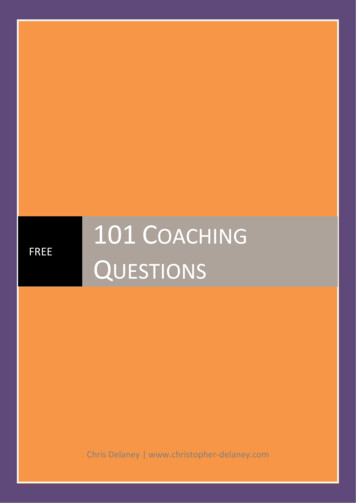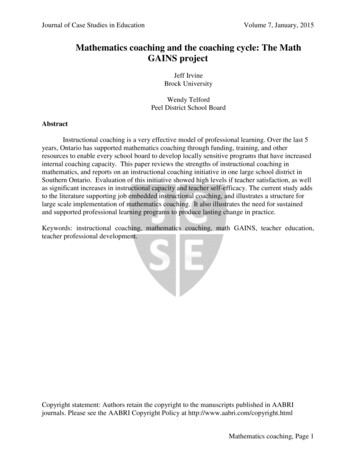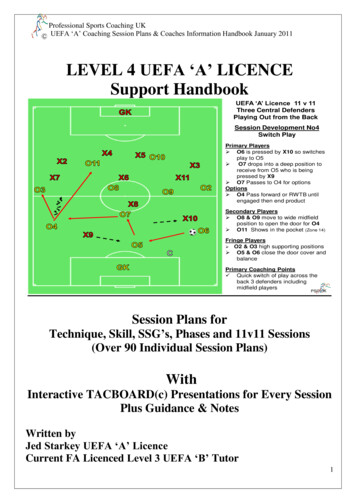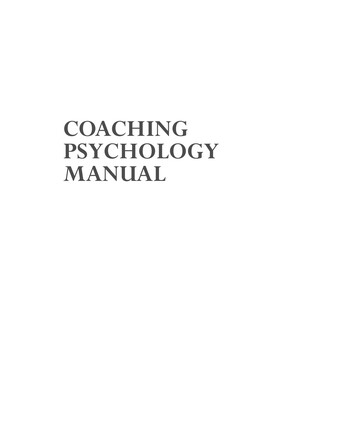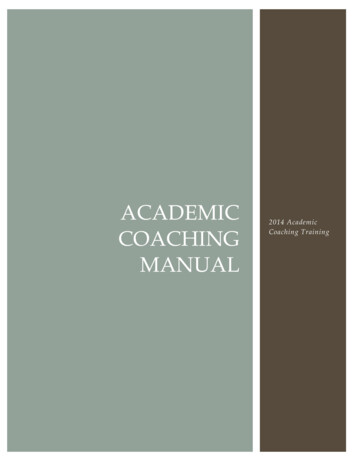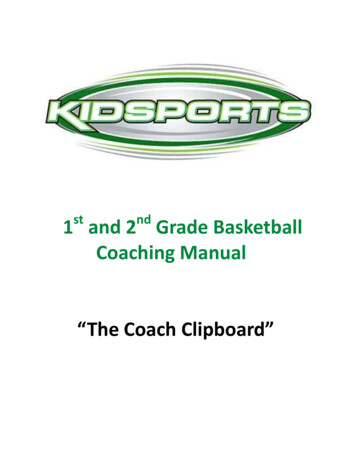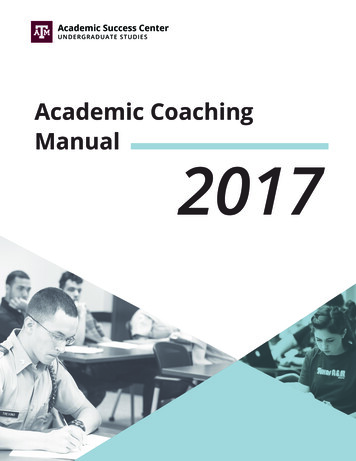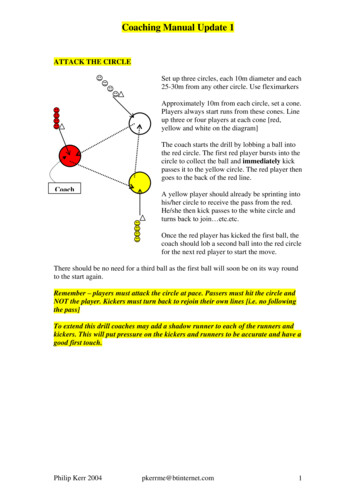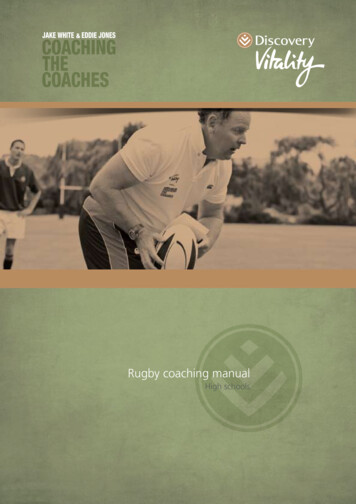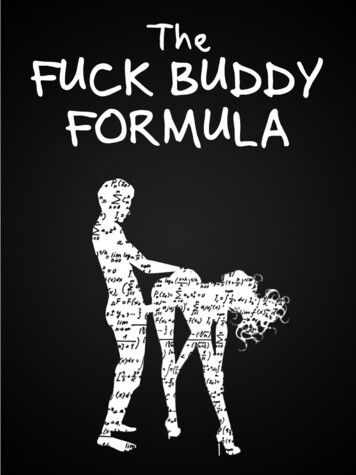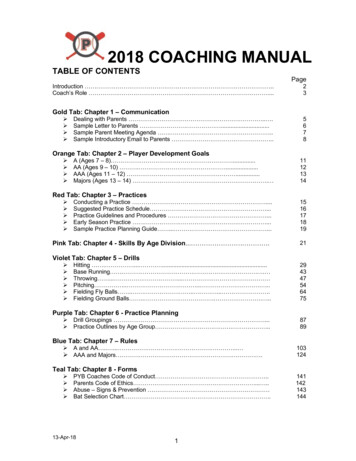
Transcription
2018 COACHING MANUALTABLE OF CONTENTSPageIntroduction .Coach’s Role .23Gold Tab: Chapter 1 – CommunicationØØØØDealing with Parents . .Sample Letter to Parents .Sample Parent Meeting Agenda . .Sample Introductory Email to Parents .5678Orange Tab: Chapter 2 – Player Development GoalsØØØØA (Ages 7 – 8) .AA (Ages 9 – 10) . .AAA (Ages 11 – 12) .Majors (Ages 13 – 14) . 11121314Red Tab: Chapter 3 – PracticesØØØØØConducting a Practice .Suggested Practice Schedule .Practice Guidelines and Procedures .Early Season Practice .Sample Practice Planning Guide . .Pink Tab: Chapter 4 - Skills By Age Division. .151617181921Violet Tab: Chapter 5 – DrillsØØØØØØHitting . . .Base Running . . Throwing . . Pitching . . . .Fielding Fly Balls . . . .Fielding Ground Balls . . .294347546475Purple Tab: Chapter 6 - Practice PlanningØ Drill Groupings .Ø Practice Outlines by Age Group . .8789Blue Tab: Chapter 7 – RulesØ A and AA . . . Ø AAA and Majors .103124Teal Tab: Chapter 8 - FormsØØØØPYB Coaches Code of Conduct .Parents Code of Ethics . .Abuse – Signs & Prevention Bat Selection Chart .13-Apr-181141142143144
2018 COACHING MANUALINTRODUCTIONThe 2018 Pewaukee Youth Baseball season began, believe it or not, in the fall of 2016. Overtwenty coaches, parents and community members make up the 2018 PYB Leadership Team.One of our priorities has been to create a document (or manual) that will assist all of ourcoaches, both new and experienced, and at any age level in further developing our Pewaukeeyouth baseball players throughout the season. This manual is intended to serve this purpose.In addition, we set five major player development goals for each age division along withdefining different skills and drills necessary to help reach these goals. We also updated ourleague rules to support our desire to build a more competitive program. Combined with inputfrom over ten coaches in PYB, Pewaukee Pirates Varsity Head Baseball Coach AdamDobberstein and notes from Cal Ripken’s book “Coaching Youth Baseball the Ripken Way”,comes the first edition of the PYB Coaches Manual.We hope that you find this manual useful in developing our youth baseball players. We lookforward to hearing any suggestions you have on how to improve the information in thecoaches manual, or anything else in regard to Pewaukee Youth Baseball.Play ball!!!Thank you,2018 PYB Player/Coach Development Committee13-Apr-182
2018 COACHING MANUALCOACH’S ROLEThe Pewaukee Youth Baseball Association is most appreciative that people volunteer theirtime and effort to be a coach. Good coaches are always needed as they serve such animportant role in our baseball program. There is more to it than passing out schedules andmaking out line-up cards, and we would like to point out some of the things we consider to beimportant.Coaches often set the tone of their players' approach to the program. Success as a coachshould not be measured by wins and losses. If players complete the season having enjoyedtheir coach, teammates and themselves, as well as having improved their skills and lookahead to their next sports involvement, then a coach has been successful.Actions speak louder than words. Players see their coaches as leaders. The manner inwhich coaches deal with the players, frustrations, umpires and other teams is very important.How can coaches expect good sportsmanship from players if they fail to display itthemselves? Players remember what coaches did longer than they remember what coachessaid.Coaches should be positive in their approach to coaching a team. A positive approachmotivates kids to perform in a desirable way while a negative approach, based on fear, doesnot. Rewards are a key to motivation. Rewards can range from verbal praise to a simplesmile. Look for the little things that are positive and reward your players. This will encouragethem and improve performance and behavior. An immediate reward upon completion of apositive act is more meaningful than a passing mention many minutes later. Remember,reward effort as much as results because children can completely control their effort.Encouragement is also an important part of a positive approach. Encourage effort, do notdemand results. Encouraging players to attempt a new skill may result in some mistakes.Most kids feel embarrassed when they try a new skill and make a mistake, but the most usefulthing a coach can do is encourage them immediately after such mistakes occur. Be patient!A coach should allow players to assist in formulating team rules. When rules have beendetermined, explain them thoroughly to the team. Be consistent in your interpretation at alltimes. Be firm with those who violate the rules and be sure they understand what they did tocause the violation. Remind your players that rules will be enforced based on the principlethat everyone is equal. Praise publicly, redirect privately.Teach players to respect the rights of others, to encourage teammates, and to not harassopponents. Help players accept defeat gracefully and learn from the experience. We hopesuch leadership carries over to the parents of the players. The conduct and values ofcoaches and parents play vital roles in creating a wholesome environment in which playerslearn the game.THANK YOU FOR FACING THE CHALLENGE. WE APPRECIATE YOUR HELP!13-Apr-183
2018 COACHING MANUALTHIS PAGE INTENTIONALLY LEFT BLANK13-Apr-184
2018 COACHING MANUALDEALING WITH PARENTSCoaching a youth league team is exciting and rewarding. But from time to time, you mayexperience difficulty with parents. Some may want their children to play more or they mightquestion your judgment as a coach. This is normal, so don’t feel that you’re alone if thishappens. Here are a few thoughts to remember when dealing with parents:Ø Know what your objectives are and do what you believe to be of most value to the team,not the parents.Ø Encourage parental involvement. Always listen to their ideas and feelings. Remember,they’re interested and concerned because it’s their children who are involved.Ø Express appreciation for their interest and concern. This will make them more open andat ease with you.Ø No coach can please everyone. Don’t try.Ø Most importantly, be fair. If you treat all players as equals, you will gain their respect.Ø Resist unfair pressure. You are the coach and it’s your responsibility to make the finaldecision.Ø Don’t blame the players for their parent’s actions. Try to maintain a fair attitude.Ø Make certain all parents know your ground rules. Have your rules, regulations,philosophy, practice dates and times, etc., printed and distributed to all parents. Ifnecessary, have a parent meeting before the season begins to discuss your operatingprocedures.Ø Be consistent! If you change a rule or philosophy during the season, you may be in fortrouble. If you do change something, make sure the parents are informed as soon aspossible.Ø Handle any confrontation one-on-one and not in a crowd situation. Don’t be defensive.Don’t argue with parents. Listen to their views and be thankful.Ø Don’t discuss individual players with other parents. The grapevine will hang you everytime.Ø Ask parents not to criticize their children during a practice or game. Don’t let your playersbe humiliated, even by their own parents. Explain that you as the coach must be givencomplete control of your team when they are on your “turf.”Ø Parents must accept the fact that umpires, coaches and other league officials arevolunteers and should not be subjected to public criticism.Ø Communication throughout the season or even weekly is recommended. Let the parentsknow what is being worked on in practice and what can be worked on at home.Always remember that you will be dealing with children and parents with different backgroundsand ideals. One of your main challenges as a coach is to deal with these differences in apositive manner so the team’s season will be an exciting and enjoyable experience for all.13-Apr-185
2018 COACHING MANUALSAMPLE LETTER TO PARENTSDear Parents:Here are some hints on how to make this a fun season, with lots of positive memories for yourkids and your family.1. Make sure your kids know that, win or lose, you love them. Be the person in their life theycan always look to for support.2. Try to be completely honest with yourself about your kids’ athletic capability, theircompetitive attitude, their sportsmanship, and their skill level.3. Be helpful, but don’t coach your kids on the way to the game or at the breakfast table.Think how tough it must be on them to be continually inundated with advice, pep talks andcriticism.4. Teach your kids to enjoy the thrill of competition, to be out there trying to be constantlyworking to improve their skills, to take physical bumps and come back for more. Don’t tellthem that winning doesn’t count because it does and they know it. Instead, help themdevelop a healthy competitive attitude, a “feel” for competing, for trying hard, for having agood time.5. Try not to live your life through your kids. You’ve lost as well as won, you’ve beenfrightened and you’ve backed off at times. Sure, they’re an extension of you, but don’tassume they feel the same way you did, want the same things, or have the same attitude.6. Don’t push them in the direction that gives you the most satisfaction. Don’t compete withyour kids’ coaches. A coach may become a hero to your kids for a while, someone whocan do no wrong, and you may find that hard to take. Conversely, don’t automatically sidewith your kids against their coaches. Try to help them understand the necessity fordiscipline, rules and regulations.7. Don’t compare your kids with other players on their team – at least not within their hearing.Don’t lie to them about their capabilities as a player. If you are overly protective, you willperpetuate the problem.8. Get to know your kids’ coaches. Make sure you approve of each coach’s attitude andethics. Coaches can be influential, and you should know the values of each coach so thatyou can decide whether or not you want them passed on to your kids.9. Remember that children tend to exaggerate. Temper your reactions to stories they bringhome from practice, or the game, about how they were praised or criticized. Don’t criticizethem for exaggerating, but don’t overreact to the stories they tell you.10. Teach your kids the meaning of courage. Some of us climb mountains, but turn into jelly atthe sight of a bee. Everyone is frightened about something. Courage is learning to performin spite of fear. Courage isn’t getting rid of fear - it’s overcoming it.11. Winning is an important goal. Winning at all costs is stupidity.12. Remember that officials are necessary. Don’t overreact to their calls. They have rules andguidelines to follow representing authority on the field. Teach your kids to respect authorityand to play by the rules.13. Finally, remember if the kids aren’t having fun, we’re missing the whole point of youthsports.Sincerely, The Coach13-Apr-186
2018 COACHING MANUALSAMPLE PARENT MEETING AGENDA1.Introduce yourself and assistants. (Mention what you would like to have the playerscall you).2.Explain coaching philosophy and expectations2.Explain when practices will be and how long. Where will they be held? What theplayers should bring; glove, own marked bats, WATER, etc.3.Help Needed: PracticesGamesTeam Parent4.Team Rules5.Every player plays, but only if you see the commitment. Please call if not able to makea practice or game.6.Please don’t badger son/daughter about playing a position. All players will get achance to try different positions.7.Hand out uniforms. Uniforms are to be worn to every game.8.RAINOUTS:Inclement weather may force postponement of games. Field information will be postedon the PYB Web Site by 4:00 p.m. PLEASE DO NOT CALL THE COACHES TOSEE IF A GAME IS CANCELLED - WE WILL POST IT AS SOON AS WE KNOW.9.Hand out Schedules, parent code of conduct forms and information letters.10.Questions13-Apr-187
2018 COACHING MANUALSAMPLE INTRODUCTORY EMAIL TO PARENTS2016 PEWAUKEE YOUTH BASEBALLTEAM NAMECOACHES:Head Coach:Assistant Coach:Assistant Coach:name, phone number, emailname (Home phone)name (Home phone)TEAM OBJECTIVES: To have fun learning to play and practice baseball. Learn how to exhibit good sportsmanship, the importance of teamwork and respect. Skill developmento How to swing and hito How to play the field and get outso Learning the rules of baseballCOMMUNICATION:Please feel free to contact any of the coaches throughout the season regarding any problems,questions or comments you may have regarding your child. To keep a high level ofcommunication, PYB and I will communicate mostly through email. Please let us know of anyaddress, phone or email changes throughout the season.PRACTICES:Attached is a practice schedule for May.Saturdays:11:00 a.m. – 1:00 p.m., Springdale Park EXCEPT May 5th & May 12th whenpractice will be from 1:00 p.m. – 3:00 p.m. at Springdale Park.Thursdays:5:00 p.m. – 6:30 p.m., South Park, East DiamondWe ask that all players attend practice, as they are as important as games. If you cannotattend a practice, please notify me.EQUIPMENT:A cap, socks, and jersey are provided with your PYB fee. A player must supply his own whitebaseball pants, available at most area sporting goods stores. A comfortable pair of baseballshoes is also recommended. Also, it is important to have a glove, which is “broken in.”Players may also bring their Little League approved bats. PLEASE PLACE YOUR NAME ONALL ITEMS, INCLUDING INSIDE THE BOTTOM BILL OF THE CAP. Uniforms should bedistributed before the first game.RULES:I have copies of the key minor league rules. Please ask if you would like a copy, otherwisethey are available on the web site.13-Apr-188
2018 COACHING MANUALSAMPLE INTRODUCTORY EMAIL TO PARENTS (con’t)GAMES:We may play two or more games each week. Most of our games are on weekdays. If yourchild cannot attend a game, please notify the head coach as soon as possible. After theseason has begun, we will hold our practice/warm-up 30 minutes prior to each game. Pleasebring a water bottle to each game.PARENT PARTICIPATION:The coaches will always welcome additional help for practices and games. If you areavailable, please let us know, and we will assign you a role. We will need a parent umpire foreach game. It is helpful if every family takes at least one turn at this. When we are the hometeam, we need to supply the home plate umpire.PARENT CODE OF CONDUCT:PYB has established a parent code of conduct. Please sign a copy and familiarize yourselfwith this policy.TEAM PARENT:We need a volunteer to develop and coordinate a snack and umpire schedule.RAINOUTS:Inclement weather may force postponement of games. Field information will be posted at thePYB Web Site by 4:00 p.m. ALL GAMES SHOULD BE CONSIDERED ON UNLESS YOURECEIVE A CALL FROM A COACH TELLING YOU IT IS CANCELLED OR IT HAS BEENPOSTPONED. PLEASE DO NOT CALL THE COACHES TO SEE IF A GAME ISCANCELLED. WE WILL NOTIFY YOU AS SOON AS WE KNOW.WEBSITE:The best way to keep up to date on practice and game schedules as well as standings andother PYB news is the website www.pewaukeeyouthbaseball.org.PYB TOURNAMENT OF CHAMPIONS:Following the regular season we will have our year ending PYB Tournament of Champions.SPONSORSHIP LOYALTY CARD:Each player will receive four loyalty cards to distribute to family, friends and neighbors.Please patronize our sponsors and thank them for their support.PYB is a recreational league that stresses fun, teamwork and sportsmanship. We areteaching how to be humble in victory & gracious in defeat while learning America’s greatestgame – baseball!13-Apr-189
2018 COACHING MANUALThis page left intentionally blank13-Apr-1810
2018 COACHING MANUALPLAYER DEVELOPMENT GOALS FOR A (AGES 7 - 8)1. Learn the basic rules of baseballa. Correct direction to run when the ball is hitb. How is an out made (catch the ball in the air, throw to first, tag a runner)c. Running past firstd. Scoring a rune. Three outs in an inning in regular baseball2. Mechanics of Throwinga. Front shoulder points towards the targetb. Keep the elbow above the shoulderc. Step towards the target with the non-throwing footd. Release the ball3. Following the Balla. Follow the ball into the glove either on the ground or in the airb. Use two hands to catch the ballc. Catch the ball out in front of your body4. Hittinga.b.c.d.e.Proper way to hold the batProper way to swing the batBatting safety (never swing when others are around, wear a batting helmet)Hitting off a teeHitting soft toss5. Playing Positions – learn when the ball is yours and when to let someone else field it13-Apr-1811
2018 COACHING MANUALPLAYER DEVELOPMENT GOALS FOR AA (AGES 9 - 10)1.Learn the basic rules of baseballa. What is a force out?b. Tagging upc. Baserunning (when you don’t have to run, not passing teammate on thebasepaths)d. Balls & Strikes2.Mechanics of Throwinga. Four seam gripb. Point the front shoulder, step and throwc. Introduce concept of generating momentum towards the target and followingthe throw3.Catching and Fieldinga. How to field thrown and hit ballsb. Fingers up versus fingers downc. See the ball and the gloved. Use two handse. Forehand and backhand fieldingf. Underhand flipg. Crossover and drop steps4.Hittinga. Proper bat selectionb. Proper gripc. Introduce drills for hitting off a tee, soft toss and short tossd. Emphasize Tee drills5.Playing Positionsa. Learn the positions and the areas each position coversb. Where to cover when the ball is not hit to youc. Cutoff and relay basics13-Apr-1812
2018 COACHING MANUALPLAYER DEVELOPMENT GOALS FOR AAA (AGES 11 – 12)1. Learn the basic rules of baseballa. Infield fly ruleb. Balks2. Base runninga. Leadsb. Stealsc. Extra-base hits3. Pitching and Throwing Mechanicsa. Wind-up versus stretchb. Four-seam gripc. Shuffle, throw and followd. Pitcher covering first4. Hittinga. Drill Work (tee, soft toss, short toss, stickball, lob toss, one-arm drill)b. Buntingc. Emphasize Tee drills5. Learning Team Fundamentalsa. Cutoffs and relaysb. Bunt defensesc. First and third situationsd. Underhand flip and double playse. Defending the stealf. Communication between infield and outfield13-Apr-1813
2018 COACHING MANUALPLAYER DEVELOPMENT GOALS FOR MAJORS (AGES 13 – 14)1. Pitching and Throwing Mechanicsa. Emphasis on momentum towards the target and follow throughb. Breaking balls and change-upsc. Pitching mechanics and proper body usaged. Pickoffse. Drillsf. Introduce long toss2. Hittinga.b.c.d.Teach situational hitting (inside-out swing, hitting behind runners, hit and run)Sacrifice bunting versus bunting for a hitUnderstanding the countEmphasize Tee drills3. Base runninga. First and third situationsb. Stealing and delayed stealsc. Recognizing and reacting to situations4. Fieldinga. Crossover and drop stepsb. Backhands and when to use themc. Double-play depthd. Pitcher covering firste. Infield communication5. Learning Team Fundamentalsa. Pick-off playsb. Full bunt defensesc. Full first and third situationsd. Pop-up and fly ball prioritiese. Double plays and underhand flips13-Apr-1814
2018 COACHING MANUALCONDUCTING A PRACTICEWhen conducting a practice, it is important to use your time efficiently. Keep yourpractice simple and use drills that involve all players. The following are points toconsider when planning a practice schedule:1. It is helpful if you can secure a staff of at least two assistant coaches. The basicphilosophy of the team should be established and agreed upon by all the coaches.2. It’s important to have enough balls, bats, helmets, etc., on hand for practice andgames.3. Try to secure a field that is properly maintained. It’s difficult to teach proper fieldingtechniques on a poor field.4. Know the attitudes of the players and parents. Hold a general meeting prior to theseason to let both the players and parents know your philosophy and expectations.5. Try not to get in a rut as you set up your practice schedule - add new drills and changeprocedures to keep practice interesting.6. Require all your players to obey instructions.7. Practice means work, but it should also be enjoyable.8. Require your players to always give their best effort. Hard work and hustle should beexpected and rewarded.9. Teach your players to encourage their teammates at all times. Make it clear that oneplayer criticizing another will not be tolerated.10. Understand the difference between correction and criticism. Correction deals with theproblem. Criticism is directed at the player and almost always has a negative effect.11. Remember that each player is someone’s son or daughter and develop a caringrelationship with each one.12. Most importantly - STAY POSITIVE AND HAVE FUN!13-Apr-1815
2018 COACHING MANUALSUGGESTED PRACTICE SCHEDULEThe time and order of each activity will be dictated by the length of practice.1. WARM UPa. Run. A slow jog stimulates blood flow to the muscles and joints.b. Stretch. Stretching exercises should include upper and lower body musclegroups.c. Throw. Begin with short throws to get loose and slowly progress to long throws,which will stretch and strengthen players’ arms.2. DRILLS/STATIONS – Work on fundamentals (See Chapters 5,6 and 7)3. BATTING PRACTICEOnly one player at a time can hit live pitching, so it’s important to incorporate a numberof hitting drills to ensure everyone gets plenty of swings. The three-station approachwill allow hitters to rotate from the tee station to the soft toss station to live battingpractice. Fielders should also be getting in quality work during batting practice. Theycan either play the ball live off the bat or take fungoes between pitches.4. SIMULATED GAMEThe simulated game pulls together everything worked on in practice. Players practicereacting to game situations and learn about the value of thinking before every pitch.Start with one player at each position and have the remaining players be base runners.The coach first gives a situation and then hits a ball in play. The fielders and baserunners react accordingly.5. CONDITIONINGThe last part of practice should be devoted to conditioning. This is a great opportunityto combine a base running drill with conditioning. Have players take turns simulating aswing and running out a single. After a short rest, continue with a simulated double,triple and home run.13-Apr-1816
2018 COACHING MANUALPRACTICE GUIDELINES AND PROCEDURES1. Schedule fields through the Pewaukee Youth Baseball.2. Be at a practice if you call one.3. Check field for safety. Also, carry first aid supplies, washcloth, ICE.4. Have a plan for each practice. Copy of Drills.5. Player must be excused or attend practice to play in games. Coaches must use theirown judgment, but take attendance at every practice to back up any action you mayhave to take. Remember, this is a RECREATION League. Every player seated on thebench during the game must play.6. ONE-ON-ONE, Get to know your team. Try to have one-on-one time with every playerduring the season. Ask:a. What they like to be calledb. Family - are they oldest, youngest (this affects performance)c. Find out what type of encouragement works for each person (verbal, pat on theback, etc.)d. Do they have fear of getting hit or missing a catch.7. THE TEAM - Develop the team. Each individual is important to the whole group. Theyback up each other. End every practice with a review of what you did that session.Recognize who especially helped out the "team".8. Give positive reinforcement at the exact time the behavior occurs. Do not wait until theend of the practice to compliment or correct something. This should be at the top ofyour motivational list.9. PYB encourages practice during the regular game season. Be cautious not to coachtoo much during a game. Keep those teaching opportunities from games in the back ofyour mind or on paper. Practices are the best time to reinforce the goals and skills youare trying to teach. Let the players have fun and play the game.10. Make sure every player has a way home. You are not a taxi service, but you areresponsible for that player during practice time.11. Do not leave practice or a game until every player has been picked up. Coaches arethe last ones to leave.13-Apr-1817
2018 COACHING MANUALEARLY SEASON PRACTICESpring is just around the corner and with spring, comes a new Baseball season. The newseason brings hope, optimism, and many long afternoons in the sun. Sounds pretty gooddoesn’t it?After a long winter rest, your players will need to get into condition slowly and carefully. Hereare a couple of tips for those first few practices:1. Be sure to spend plenty of time stretching and performing light calisthenics. Many playersmay not be ready to play at first and will need time to get back to game shape.a) Start with an easy run.b) Spend some time on stretching – Start with neck, working down through the othermuscles.c) Spend 10 minutes easy throwing – First short (30-40 feet) working outwards to 100feet. Be sure to start with slow speeds and work upwards from there.2. The first set of drills should focus on skill development. Make sure to spend adequateamounts of time working on basic throwing, catching, fielding and base running skills.a) Divide your team into groups: Create stations for pitchers, catchers, infielders andoutfielders.b) Pitchers can begin to work on their delivery throwing at ½ to ¾ speed.c) Catchers should work on fielding wild pitches, proper stance, fielding bunts, andbasic throwing mechanics.d) The infield team should work on fielding ground balls, double play pivots andplacements, and moving the ball around the infield.e) The outfield team should work on fielding ground balls, hitting their cutoff man, andlearning how to judge and cover the gap.f) Have all the groups rotate through the stations3. The next priority will be to get your players to begin to play together as a team. Yoursuccess will be based on how the team reacts (as a group) to the ball when it is inplay, so look for drills which focus on group participation.a) Try to simulate real game situations.b) Work on getting the runner out with a minimum amount of throws.c) Cover special situation plays like steals, double plays and pick-offs whenappropriate.The seeds of a successful season are sown early. Get off to the right start and you willexperience a greater amount of success and make the season more enjoyable foreveryone.13-Apr-1818
2018 COACHING MANUALSAMPLE PRACTICE PLANNING GUIDEDATE:PRACTICE GOALS/OBJECTIVES: 1.2.3.TIME13-Apr-18ACTIVITYKEY TEACHING POINTS19DRILLS
2018 COACHING MANUALThis page intentionally left blank13-Apr-1820
2018 COACHING MANUALSKILLS BY AGE DIVISIONSCal Ripken, Sr. always said, “Baseball is a simple game played with bats, balls, and people”.No matter what level at which you play, the team that throws, catches, and hits best wins.Consider this and use caution when reviewing the following spreadsheet of skills. Refer backto Orange Tab for the separate division goals when setting practices and working on playerskills. Shaded areas have drills in the Purple Tab.TEAM OFFENSEHitting:Stance & StrideWeight Shift and PivotSwing MechanicsAAAAAAAAABunting:Drag or PushSac to 1st/3rdSqueezeHit and Run/Run and HitRunner on 3rd: Infield UpRunner on 3rd: Infield BackMoving Runner to 3rd, No OutsFake Bunt and SlashWorking the countBaserunning:Leads: 1st base/rulesLeads: 2nd base/rulesLeads: 3rd base/rulesHome to 1st rulesHome to 2nd rulesHome to 3rd rulesTagging-up from 1stTagging-up from 2ndTagging-up from 3rdStraight StealDelay stealHit and Run/SlashSqueezeRundownsPicked off 1st13-Apr-18AAAAAAAAAMajors Jr PiratesMajors Jr PiratesMajors Jr ajorsMajorsMajorsJr PiratesJr PiratesJr PiratesJr PiratesJr PiratesJr PiratesJr PiratesJr PiratesJr ajorsMajorsMajorsMajorsMajorsMajorsMajorsMajorsJr PiratesJr PiratesJr PiratesJr PiratesJr PiratesJr PiratesJr PiratesJr PiratesJr PiratesJr PiratesJr PiratesJr PiratesJr PiratesJr PiratesJr AAAAAA
2018 COACHING MANUALRunner picked behind youRunner picked in front of youTipping PitchesSliding:Head FirstFeet FirstSwitch HandsBatting Practice RoutineSignals from 3B CoachSignals from 1B CoachTEAM DEFENSEHustle to PositionsBetween Inning ResponsibilitiesBunts: (Signal System)Standard-Man on FirstStandard-1st and 2ndSpecial PlaySpecial Play Pick-OffSqueezeFirst and Third Steal (Signal System)Straight StealDelay stealEarly Break 1st/3rdFake Bunt/StealPickoff System (Signal System)From Catcher to BaseFrom Pitcher to BaseIntentional Walk PositioningDefensive Positioning SignalPitch Calling SystemTandem Relay SystemSacrifice Fly RelayGroundball Base Hit RelayGame AdministrationPre-game ScheduleGame Administration Policies13-Apr-18AAAAAAAAAAMajors Jr PiratesMajors Jr PiratesMajors Jr PiratesAAAMajorsJr PiratesJr PiratesJr PiratesJr PiratesJr PiratesJr AMajors Jr PiratesMajors Jr rsJr PiratesJr PiratesJr PiratesJr Pira
2018 COACHING MANUAL 13-Apr-18 6 SAMPLE LETTER TO PARENTS Dear Parents: Here are some hints on how to make this a fun season, with lots of positive memories for your kids and your family. 1. Make sure your kids know that, win or lose, you love them. Be the person in their
